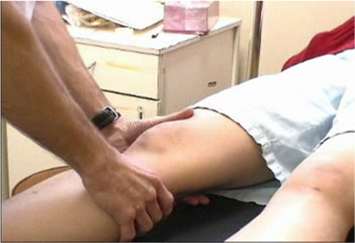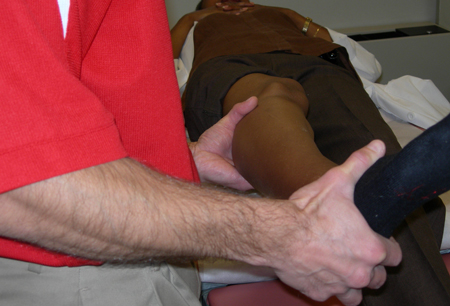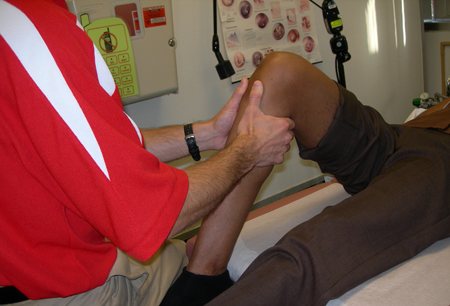History and exam
Key diagnostic factors
common
audible pop
Reported in up to 70% of ACL tears. If positive, greatly heightens suspicion, but lack of pop does not rule out ACL injury.[58]
rapid knee swelling
Patients usually present acutely, within a few hours of injury and typically report rapid development of marked knee swelling.
inability to return to the ongoing sporting activity
Patients may be able to hobble or jog a little but are rarely able to return to the ongoing sporting activity.
sensation of knee instability or buckling
Patients often describe a sensation of the femur and tibia twisting apart from each other or the knee feeling loose.
pain
Varies greatly. Some describe minimal pain, others describe severe pain. Not a very useful discriminator.
positive Lachman test
The most accurate maneuver for detecting an acute ACL tear.[47][48]
The Lachman test is performed with the patient in a supine position. The patient’s knee is positioned at 20 to 30 degrees of flexion. One hand is placed on the patient’s thigh and the other behind the tibia, with the clinician's thumb on the tibial tuberosity. The tibia is then pulled anteriorly. If the ACL is intact, a firm endpoint is felt. If this does not occur, and there is >2 mm of anterior movement compared with the uninjured knee, the test is positive, suggesting a torn ACL. [Figure caption and citation for the preceding image starts]: Lachman maneuverFrom the personal collection of Philip H. Cohen [Citation ends].
positive pivot shift maneuver
The patient is in the lateral decubitus position and the examiner holds the patient's leg with both hands. The knee is at 20 degrees of flexion and the patient is asked to relax the muscles. The examiner then places the knee in full extension and internally rotates the tibia.[Figure caption and citation for the preceding image starts]: Pivot startFrom the personal collection of Philip H. Cohen [Citation ends]. Then the knee is pushed from the lateral side and flexed.[Figure caption and citation for the preceding image starts]: Pivot finishFrom the personal collection of Philip H. Cohen [Citation ends].
Then the knee is pushed from the lateral side and flexed.[Figure caption and citation for the preceding image starts]: Pivot finishFrom the personal collection of Philip H. Cohen [Citation ends]. If a clunk is felt at 30 degrees, the test is positive for ACL rupture.
If a clunk is felt at 30 degrees, the test is positive for ACL rupture.
Highly specific, less sensitive, especially acutely. Technically difficult to perform for many physicians, but best test for dynamic rotatory instability. May correlate better with real world function than the other tests.[50] Usually done under anesthesia in the operating room prior to/after reconstruction.
Other diagnostic factors
common
tenderness at lateral femoral condyle, lateral tibial plateau
Often due to kissing bone bruises that occur when femur and tibia bang against each other when the ACL tears.[Figure caption and citation for the preceding image starts]: T1-weighted MRI showing ACL tearFrom the personal collection of Philip H. Cohen [Citation ends]. Tenderness at the tibiofemoral joint line may also indicate a meniscal tear, but is difficult to distinguish on initial exam.
Tenderness at the tibiofemoral joint line may also indicate a meniscal tear, but is difficult to distinguish on initial exam.
positive anterior drawer test
This test involves placing the patient in a supine position, flexing the hips to 45 degrees, with the knees at 90 degrees and the patient's feet on the table.[Figure caption and citation for the preceding image starts]: Anterior and posterior drawer test starting positionFrom the personal collection of Philip H. Cohen [Citation ends]. Sitting on the patient's feet, the clinician takes hold of the tibia and pulls it anteriorly. If the tibia moves more than usual, the test is positive. Testing will often be positive, but is less sensitive and specific.[49]
Sitting on the patient's feet, the clinician takes hold of the tibia and pulls it anteriorly. If the tibia moves more than usual, the test is positive. Testing will often be positive, but is less sensitive and specific.[49]
Risk factors
strong
acute trauma
Contact injuries, especially with hyperextension and/or valgus stress, are a classic cause of ACL tears.[22]
Noncontact injuries, especially involving sudden deceleration, pivoting, change in direction, landing from a jump, or excessive rotation and extension, are responsible for the majority of ACL tears.[23][24][25]
female sex (after puberty)
poor technique for landings
Athletes who are poorly trained or do not have a good technique are at a higher risk for improperly planting their feet and injuring the ACL.[27]
history of previous ACL injury
May be ipsilateral or contralateral.[28]
use of cleats or spikes
Cleats and spikes used during sports on grassy surfaces increase the likelihood of planting a foot and twisting the body without release, consequently twisting upon the knee joint.[30]
rough or uneven playing surface
ground condition/weather
fatigue
adolescent, young adults, and middle-aged athletes
Increased risk in adolescents and young adults, but also middle-aged athletes/skiers. Skeletally immature athletes are more likely than adults to avulse the ACL insertion rather than have an intrasubstance tear.
weak
aggressive athlete with higher skill level
Athletes who play more aggressively have a higher propensity for injury.[29]
Use of this content is subject to our disclaimer